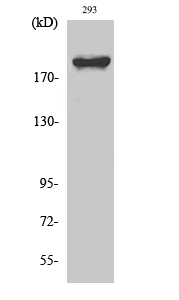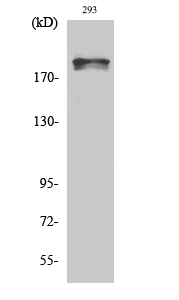Phospho WNK1 (T58) Cell-Based Colorimetric ELISA Kit
- Catalog No.:KA1226C
- Applications:ELISA
- Reactivity:Human;Mouse;Rat
- Gene Name:
- WNK1
- Human Gene Id:
- 65125
- Human Swiss Prot No:
- Q9H4A3
- Mouse Swiss Prot No:
- P83741
- Rat Swiss Prot No:
- Q9JIH7
- Storage Stability:
- 2-8°C/6 months
- Other Name:
- Serine/threonine-protein kinase WNK1 (EC 2.7.11.1) (Erythrocyte 65 kDa protein) (p65) (Kinase deficient protein) (Protein kinase lysine-deficient 1) (Protein kinase with no lysine 1) (hWNK1)
- Detection Method:
- Colorimetric
- Background:
- catalytic activity:ATP + a protein = ADP + a phosphoprotein.,caution:Cys-250 is present instead of the conserved Lys which is expected to be an active site residue. Lys-233 appears to fulfill the required catalytic function.,caution:PubMed:2507249 describes a peptide sequence containing a GlcNAc glycosylated Ser in position 164 while it is an Arg residue according to others.,cofactor:Magnesium.,disease:Defects in WNK1 are a cause of pseudohypoaldosteronism type II (PHAII) [MIM:145260]. PHAII is an autosomal dominant disease characterized by severe hypertension, hyperkalemia, and sensitivity to thiazide diuretics which may result from a chloride shunt in the renal distal nephron.,enzyme regulation:By hypertonicity. Activation requires autophosphorylation of Ser-382. Phosphorylation of Ser-378 also promotes increased activity.,function:Controls sodium and chloride ion transport by inhibiting the activity of WNK4, potentially by either phosphorylating the kinase or via an interaction between WNK4 and the autoinhibitory domain of WNK1. WNK4 regulates the activity of the thiazide-sensitive Na-Cl cotransporter, SLC12A3, by phosphorylation. WNK1 may also play a role in actin cytoskeletal reorganization.,PTM:O-glycosylated.,PTM:Phosphorylated upon DNA damage, probably by ATM or ATR.,similarity:Belongs to the protein kinase superfamily. Ser/Thr protein kinase family. WNK subfamily.,similarity:Contains 1 protein kinase domain.,subunit:Interacts with SYT2.,tissue specificity:Widely expressed, with highest levels observed in the testis, heart, kidney and skeletal muscle.,
- Function:
- protein amino acid phosphorylation, phosphorus metabolic process, phosphate metabolic process, ion transport,intracellular signaling cascade, protein kinase cascade, phosphorylation,
- Subcellular Location:
- Cytoplasm .
- Expression:
- Widely expressed, with highest levels observed in the testis, heart, kidney and skeletal muscle. Isoform 3 is kidney-specific and specifically expressed in the distal convoluted tubule (DCT) and connecting tubule (CNT) of the nephron.
- June 19-2018
- WESTERN IMMUNOBLOTTING PROTOCOL
- June 19-2018
- IMMUNOHISTOCHEMISTRY-PARAFFIN PROTOCOL
- June 19-2018
- IMMUNOFLUORESCENCE PROTOCOL
- September 08-2020
- FLOW-CYTOMEYRT-PROTOCOL
- May 20-2022
- Cell-Based ELISA│解您多样本WB检测之困扰
- July 13-2018
- CELL-BASED-ELISA-PROTOCOL-FOR-ACETYL-PROTEIN
- July 13-2018
- CELL-BASED-ELISA-PROTOCOL-FOR-PHOSPHO-PROTEIN
- July 13-2018
- Antibody-FAQs



